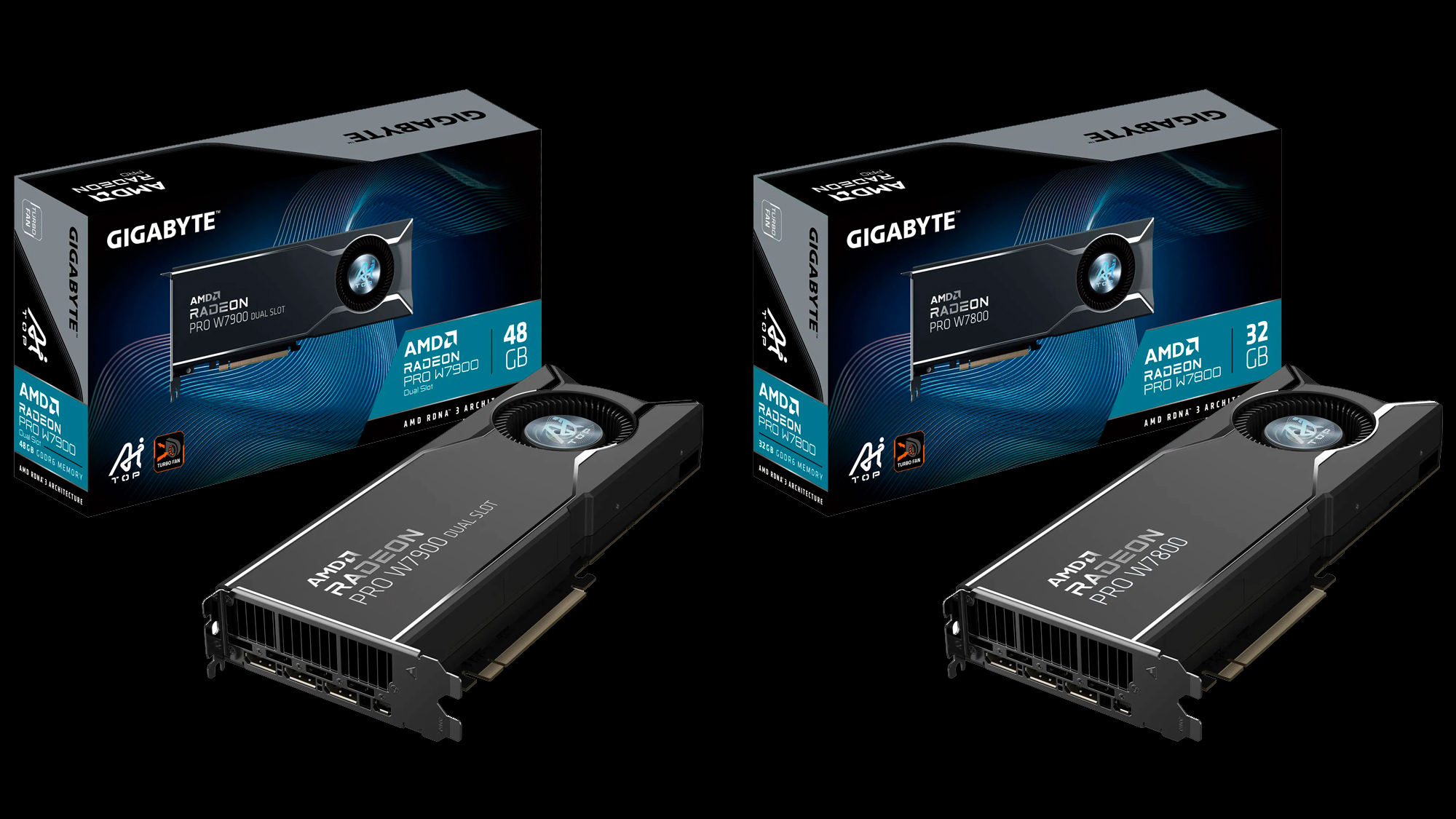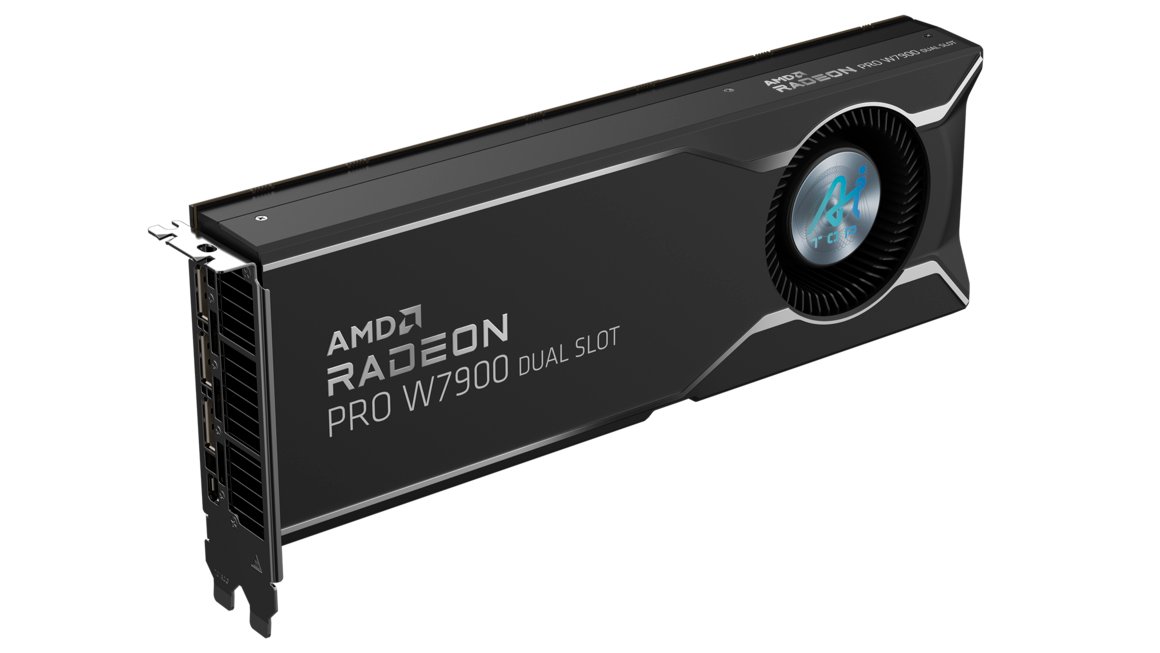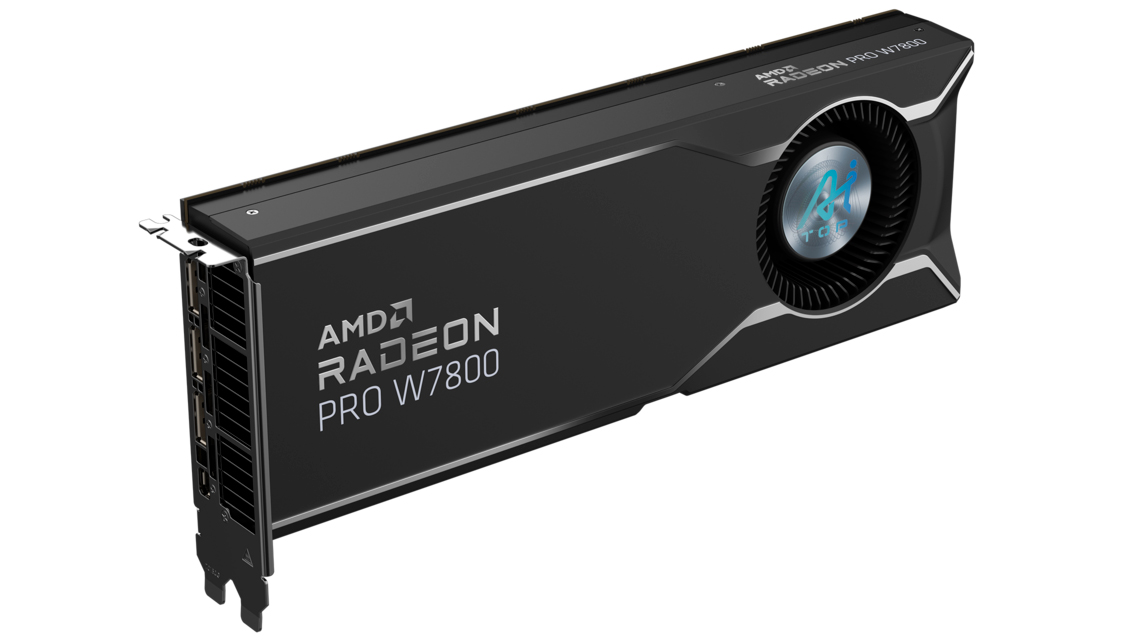Gigabyte launches AI TOP GPUs — AMD reference-like designs in fancy boxes

Gigabyte has revealed the Radeon Pro W7900 Dual Slot AI TOP 48G and Radeon Pro W7800 AI TOP 32G, the company's take on AMD's Radeon Pro graphics cards. The new offerings won't compete against the best graphics cards for gaming, as they cater to workstation users, professionals, content creators, and AI developers.
The Radeon Pro W7900 Dual Slot AI TOP 48G (W7900 AI TOP 48G) is based on the recently announced Radeon Pro W7900 Dual Slot, a more slender variant of the original Radeon Pro W7900. In terms of design, Gigabyte's iteration is a near copy of AMD's reference design. The Navi 31-based graphics card features a black blower-style cooler with a dual-slot design. Gigabyte revamped the aesthetics by compressing the graphics card's branding to three lines instead of four on the shroud and placing the "AI TOP" sticker on top of the double ball bearing fan.
Based on the Navi 31 (Plum Bonito) silicon, the Radeon Pro W7900 Dual Slot AI TOP 48G has 6,144 shaders at its disposal, along with 48GB of GDDR6 memory with ECC support across a 384-bit memory interface—the configuration results in an FP32 performance of 61.3 TFLOPS and 864 GB/s of memory bandwidth. The Radeon Pro W7900 Dual Slot AI TOP 48G features three DisplayPort 2.1 outputs and one Mini DisplayPort 2.1 output. The setup allows four 4K monitors at 120 Hz or dual 6K monitors at 60 Hz. Meanwhile, single monitor support includes 8K at 60 Hz or 12K at 120 Hz.
The Radeon Pro W7900 Dual Slot AI TOP 48G sticks to standard 8-pin PCIe power connectors and has two of them. The peak TBP (Total Board Power) is 295W, so a 750W power supply is the minimum requirement for the graphics card.


Gigabyte utilizes the same dual-slot cooler on the Radeon Pro W7800 AI TOP 32G (W7800 AI TOP 32G). There are minor aesthetic differences between AMD's reference design and its own. For example, Gigabyte's shroud lacks the silver highlight at the rear of the graphics card, and the exhaust sports a distinct design. The "AI TOP" sticker on the cooling fan helps differentiate Gigabyte's model from AMD's reference model.
The Radeon Pro W7800 AI TOP 32G utilizes a similar Navi 31 silicon as its faster sibling but only has 4,480 shaders enabled. Being a lower-tier model, the graphics card only sports 32GB of GDDR6 with ECC support, hampered by a 256-bit memory interface. The Radeon Pro W7800 AI TOP 32G delivers 45.2 TFLOPS of FP32 performance and 576 GB/s of memory bandwidth. The display output capabilities on the Radeon Pro W7800 AI TOP 32G are the same as the Radeon Pro W7900 Dual Slot AI TOP.
The graphics card comes with two 8-pin PCIe power connectors because the peak TBP for this particular SKU is 260W. As a result, it gets by with a 700W power supply at minimum, 50W lower than the Radeon Pro W7900 Dual Slot AI TOP 48G's power requirement.
Get Tom's Hardware's best news and in-depth reviews, straight to your inbox.
According to Gigabyte, all AI TOP graphics cards have passed the company's rigorous specialized testing for AI computing scenarios and are guaranteed optimal performance in such workloads. Gigabyte includes the AI TOP software that offers various features, such as memory offloading to AI TOP SSDs, a real-time dashboard to monitor the progress of AI training and the graphics card's vitals, presets for AI training, and a training scheduler.
Neither the Radeon Pro W7900 Dual Slot AI TOP 48G nor the Radeon Pro W7800 AI TOP 32G are yet available, so we don't know how much Gigabyte charges for the AI monicker. Regarding the reference models, the Radeon Pro W7900 Dual Slot retails for $3,499, while the Radeon Pro W7800 typically sells for around $2,269.

Zhiye Liu is a news editor, memory reviewer, and SSD tester at Tom’s Hardware. Although he loves everything that’s hardware, he has a soft spot for CPUs, GPUs, and RAM.
-
ThomasKinsley Making GPUs more capable handling AI is definitely worth while. RAM is cheap, so we should see eventual 64GB and 128GB cards.Reply
Meanwhile, single monitor support includes 8K at 60 Hz or 12K at 120 Hz.
As an aside, I'm guessing the refresh rates were meant to be reversed on this one. -
Notton Instead of naming it W7900 Slim, they go with W7900 AI TOPS... ughReply
The W7900 launched in 2023-04, and the only thing that changed in configuration is the card height.
It still features the same W7900-48GB, and W7800-32GB RAM configuration
Is more RAM possible with Navi-31? It's the same GPU as 7900XTX (384-bit memory bus), but is (presumably) using a clamshell design to double the capacity from 24GB to 48GB.
I haven't heard of GDDR6 getting denser chips either. -
Avro Arrow I'm a bit confused by this. I might be wrong but I thought that Radeon Pro was for things like 3D rendering while Radeon Instinct was for AI deep learning with its tremendous raw compute power. At least, that's what I understood was the reason it was chosen for Frontier and El Capitan. So now Radeon Pro is for AI as well? This is getting pretty discombobulated.Reply -
mac_angel a lot of information, but a lot of stuff missing. How do these "slim" cards measure up to the performance compared to the AMD ones? That would be a pretty big piece of information for people.Reply
On a lesser note, how does that compare to the RX 7900XTX? Yea, that's only a 24GB card, but does it make a difference? Enough for the price to matter where maybe you could install two RX 7900XTX cards for cheaper. -
jlake3 Reply
Radeon Pro W is for workstations, Radeon Pro V is for virtualized graphics in server environments, Radeon Instinct is for compute. The early Radeon Instinct cards shared die designs with graphics products and could be cross-flashed into a Radeon Pro W (with some issues), but the newer ones have dedicated die designs that ditch some of the architecture necessary for actual graphics output.Avro Arrow said:I'm a bit confused by this. I might be wrong but I thought that Radeon Pro was for things like 3D rendering while Radeon Instinct was for AI deep learning with its tremendous raw compute power. At least, that's what I understood was the reason it was chosen for Frontier and El Capitan. So now Radeon Pro is for AI as well? This is getting pretty discombobulated.
Radeon Instinct would be the choice for supercomputing and massive AI projects because it's got the most cores and the most HBM and comes in form factors that let you push the highest density, and the Pro line just doesn't have offerings that scale that high. But if you're operating on a scale and budget that's more in line with the Radeon Pro lineup, then there's no reason you can't run AI on those. -
CmdrShepard I called it in the other thread -- AI TOP is a naming scheme meant to game the SEO ranking. They should be ashamed for doing it, and everyone buying anything Gigabyte after this should be ashamed as well.Reply